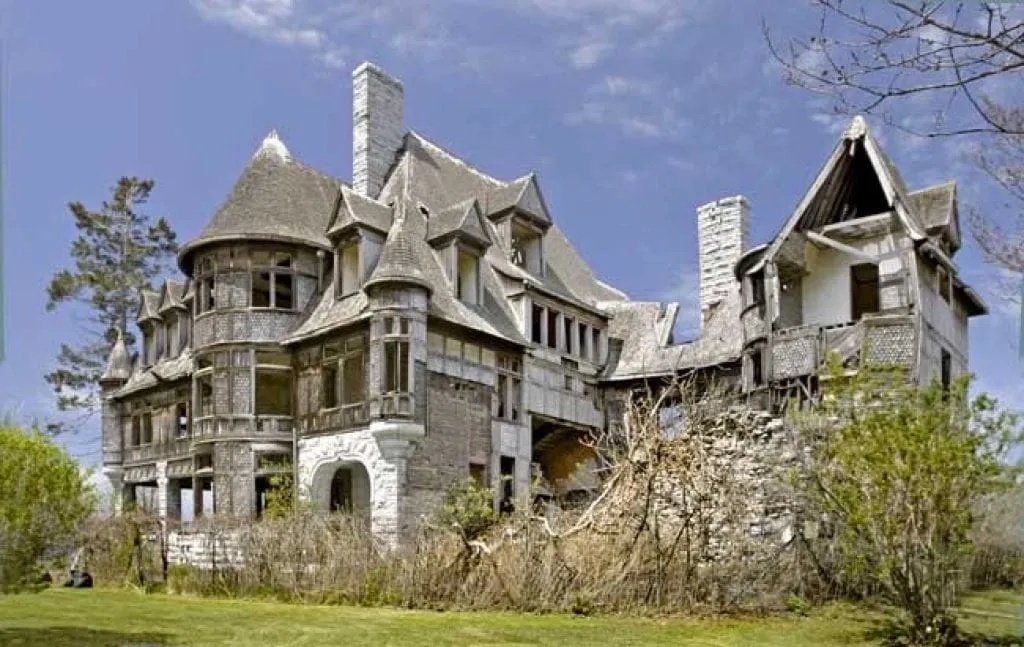Carleton Island Villa stands as a remarkable relic of the past, nestled on Carleton Island in upstate New York. Crafted in 1894 by architect William Miller, this majestic mansion was commissioned by William O. Wyckoff, whose wealth sprang from his involvement with the Remington Arms Company’s typewriter development. Positioned on the St. Lawrence River, just a stone’s throw away from the Canadian border, the island’s history traces back to its original inhabitants, the Iroquois. However, its earliest documented recognition by European settlers dates back to 1721 when French explorer Pierre Francois Xavier de Charlevoix highlighted its strategic bays, christening it Isle aux Chevreuils, translating to Island of Roe Bucks.
Over the years, the island underwent a shift in name, eventually becoming known as Carleton Island after Major General Sir Guy Carleton, who held the position of Governor of the Province of Quebec. This renaming was part of a broader initiative led by British General John Graves Simcoe, who bestowed names upon several islands in the vicinity.



During the Revolutionary War, Carleton Island played a crucial role for the British, serving as a pivotal hub for military operations. It facilitated the transfer of military supplies, hosted a naval station, and even operated as a shipbuilding yard. To safeguard these activities, the British constructed Fort Haldimand on the island. Though the fort has long vanished, traces of its presence endure in scattered ruins. Presently, the island remains uninhabited year-round, with only 34 homes scattered across its expanse. However, in the summertime, Carleton Island bursts with life, offering activities such as fishing and tourism.
In 1894, inspired by his success in the burgeoning typewriter industry, William O. Wyckoff decided to build a vacation retreat in the serene setting of Carleton Island. Entrusting the design to William Miller, a renowned architect known for his work at Cornell University, Wyckoff envisioned a grand villa. Despite the completion of construction in 1895, the reality fell short of Wyckoff’s dreams, and the villa never quite achieved the haven-like status he had imagined.



In 1895, tragedy befell the Wyckoff family when William O. Wyckoff, after spending just one night in their newly constructed home, suffered a fatal heart attack on the property. This loss came shortly after the reported passing of his wife, also due to a heart attack, a few months earlier. With Wyckoff’s untimely demise, ownership of the home transferred to his son, who maintained the property until around 1927.
However, during the tumultuous era of the Great Depression, the family encountered financial difficulties, resulting in the loss of much of their wealth. In the 1930s, General Electric acquired ownership of the property with plans to utilize it as a corporate retreat. Unfortunately, the outbreak of World War II disrupted these plans, compelling General Electric to abandon their retreat aspirations.
Subsequently, contractors were granted access to the property to salvage valuable materials such as doors, windows, and even the marble cladding from the tower base. As years passed without occupants, the structural integrity of the estate began to deteriorate. Eventually, safety concerns led to the demolition of the large tower. By this point, nearly two decades had elapsed since anyone had resided within its walls.
Now, almost a century has passed since the property last saw permanent residents, yet it stands as a silent witness to its rich history, slowly yielding to the inexorable passage of time and the harsh elements.
Presently, the current owners reside in a nearby cottage and decided to list the villa for sale several years ago. Despite its storied past and desirable location, the property has remained on the market since 2012, awaiting a new chapter in its enduring narrative.




Carleton Island Villa, listed at a relatively modest $495,000, offers a unique opportunity for potential buyers. However, any interested party must be prepared for substantial restoration expenses. The island location adds an extra financial burden, with restoration costs estimated to be approximately 30% higher compared to similar projects on the mainland. Understandably, this aspect has dissuaded many potential buyers from pursuing the property.
Nestled on 6.9 acres of land, the villa features an impressive three waterfronts: 198 feet at the front, 287 feet at North Bay, and 330 feet at South Bay. Despite its promising attributes, the property’s stone foundations and deteriorated wood frame upper floors indicate the extensive restoration required. Originally boasting 11 bedrooms and approximately 50 rooms in total, including a basement, the villa’s current state of decay and previous stripping efforts during the 1940s have obscured much of its original layout. Prospective buyers must be prepared to undertake extensive renovations, effectively starting anew to breathe life back into this historic property.





